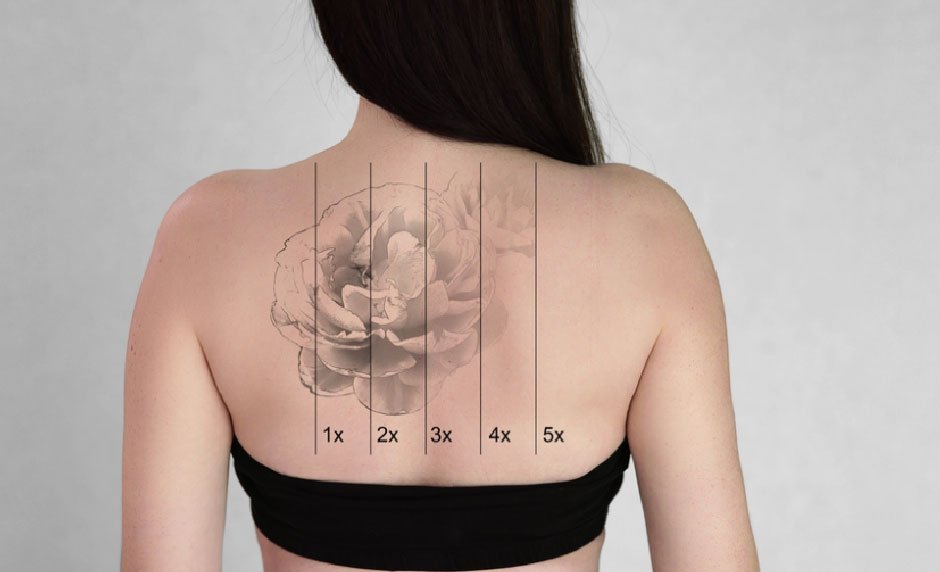Skip to the good bit
ToggleUnderstanding Tattoo Removal
Tattoos have long been a popular form of self-expression, but sometimes, people change their minds about the ink they’ve acquired. Whether it’s due to a change in personal taste, lifestyle, or career aspirations, the decision to remove a tattoo is an increasingly common one. But how long does it really take to remove a tattoo? This question doesn’t have a straightforward answer, as several factors influence the duration and success of the tattoo removal process.
Factors Affecting Tattoo Removal Time
Tattoo Size and Location
One of the most significant factors affecting how long it takes to remove a tattoo is its size and location on the body. Larger tattoos naturally require more time to remove, as each session can only cover so much area. Additionally, tattoos located on areas with thicker skin, such as the back or thighs, might take longer to fade compared to those on areas with thinner skin, like the wrists or ankles.
Ink Depth and Density
The depth and density of the ink also play a crucial role. Professional tattoos tend to be deeper and more densely packed than amateur ones. As a result, they often require more sessions to remove. The type of ink used can also affect the removal process; some inks are more resistant to laser treatment than others, making them harder to break down.
Color and Type of Ink
The color of your tattoo is another critical factor. Black ink is generally the easiest to remove because it absorbs all laser wavelengths, making it more responsive to treatment. In contrast, colors like green, blue, and fluorescent hues can be more challenging to remove, requiring specialized laser technology and more sessions.
Age of the Tattoo
Older tattoos are typically easier to remove than newer ones. Over time, the ink particles in the skin break down naturally, making them more susceptible to laser treatment. A tattoo that’s been on your skin for ten years may require fewer sessions compared to one that was done just a year ago.
The Laser Tattoo Removal Process
What to Expect During Sessions
Laser tattoo removal is the most common and effective method for removing unwanted tattoos. During a session, a high-intensity laser is used to break down the ink particles in the skin. These particles are then metabolized and eliminated by the body’s immune system over time.
Each session typically lasts between 15 to 30 minutes, depending on the size of the tattoo. However, to allow the skin to heal and the body to process the ink, sessions are usually spaced 4 to 8 weeks apart.
Number of Sessions Required
The number of sessions required varies significantly from person to person. On average, most tattoos require 6 to 10 sessions for complete removal. However, some may need fewer treatments, while others might need more. It’s essential to have realistic expectations and understand that complete removal is a gradual process.
Pain and Side Effects
Laser tattoo removal can be uncomfortable, often described as similar to the sensation of a rubber band snapping against the skin. The pain level can vary depending on the individual’s pain tolerance and the tattoo’s location. Side effects are usually mild and temporary, including redness, swelling, and blistering. It’s crucial to follow aftercare instructions carefully to ensure proper healing and minimize the risk of complications.
Choosing the Right Clinic
Importance of Professional Expertise
When considering tattoo removal, choosing a reputable clinic with experienced professionals is vital. The expertise of the practitioner can significantly affect the outcome of the removal process. In cities like Calgary, AB tattoo removal services abound, so it’s crucial to research and select a clinic with a proven track record.
Consultation and Assessment
A thorough consultation is an essential first step. During this session, the practitioner will assess your tattoo and discuss your goals, medical history, and any concerns you may have. They will then create a personalized treatment plan tailored to your specific needs, providing an estimate of the number of sessions required.
Advanced Technology
Ensure that the clinic uses advanced laser technology. Newer laser systems are more effective and can remove a broader range of ink colors. Additionally, they often result in less discomfort and shorter recovery times compared to older systems.
Aftercare and Recovery
Caring for Your Skin
Proper aftercare is crucial for successful tattoo removal. Following each session, the treated area may be red, swollen, or blistered. Keeping the area clean and applying prescribed ointments can help prevent infection and promote healing. It’s also essential to avoid sun exposure, as treated skin can be more sensitive to UV radiation.
Monitoring Progress
It’s important to monitor the progress of your tattoo removal. Take photos after each session to track the fading process. This can help you and your practitioner assess the effectiveness of the treatment plan and make any necessary adjustments.
Patience and Realistic Expectations
Patience is key when it comes to tattoo removal. While it’s natural to want quick results, the removal process takes time and varies for each individual. Setting realistic expectations and trusting the process will lead to the best outcomes.
Conclusion
Removing a tattoo is a significant decision that requires time, patience, and commitment. The duration of the process depends on various factors, including the tattoo’s size, location, age, and ink color. By understanding these factors and selecting a reputable clinic with experienced professionals, you can achieve successful tattoo removal. Whether you’re in Calgary, AB or elsewhere, taking the time to research and plan your tattoo removal journey can make all the difference in reaching your desired outcome.







